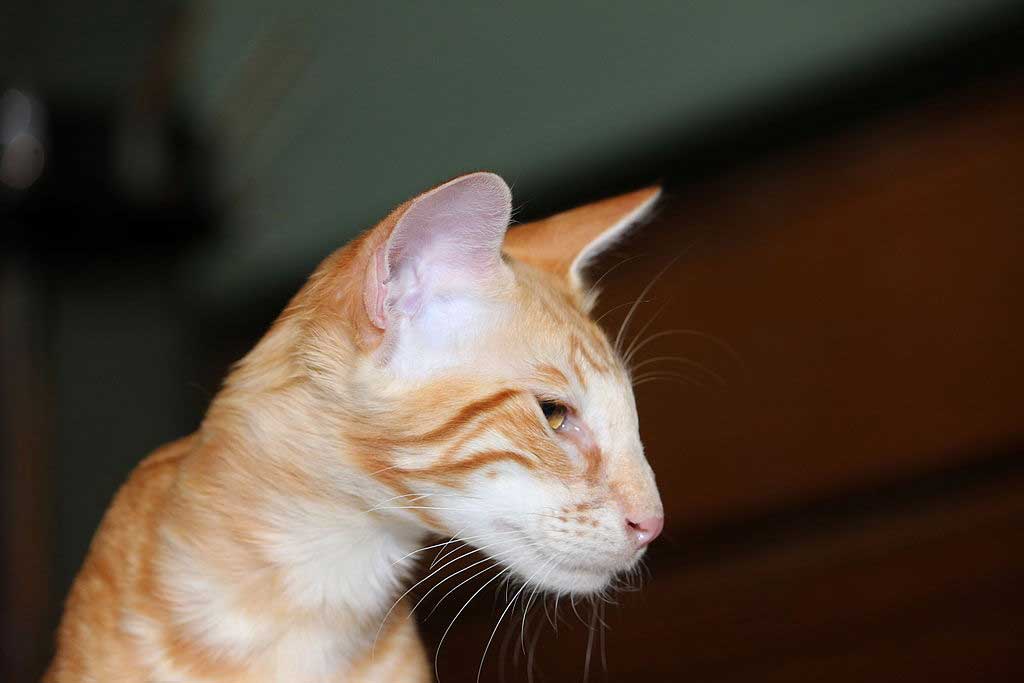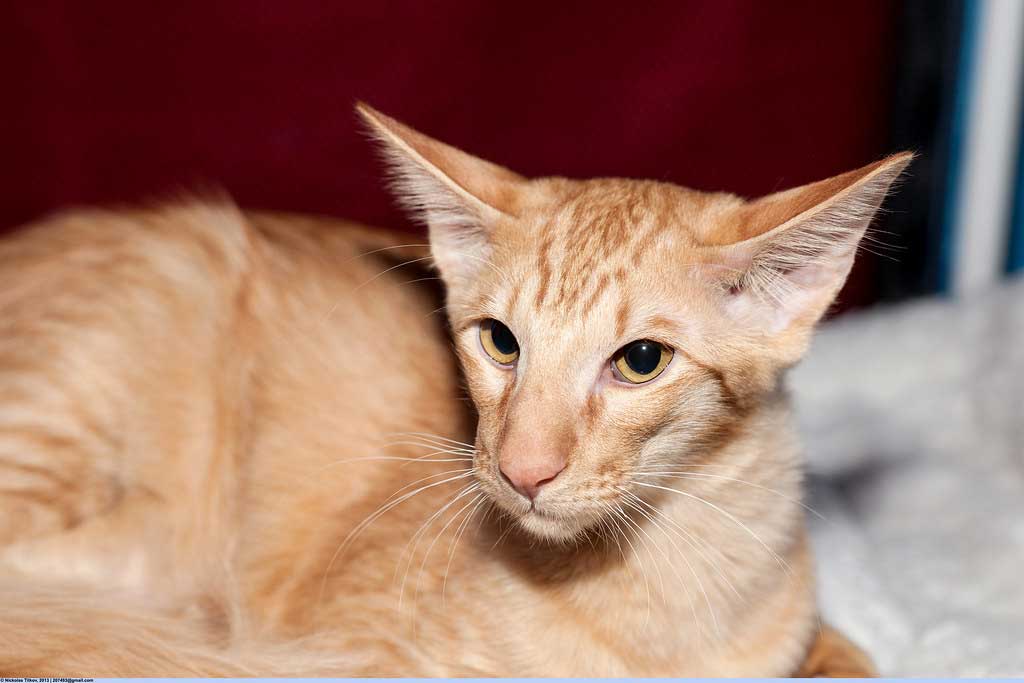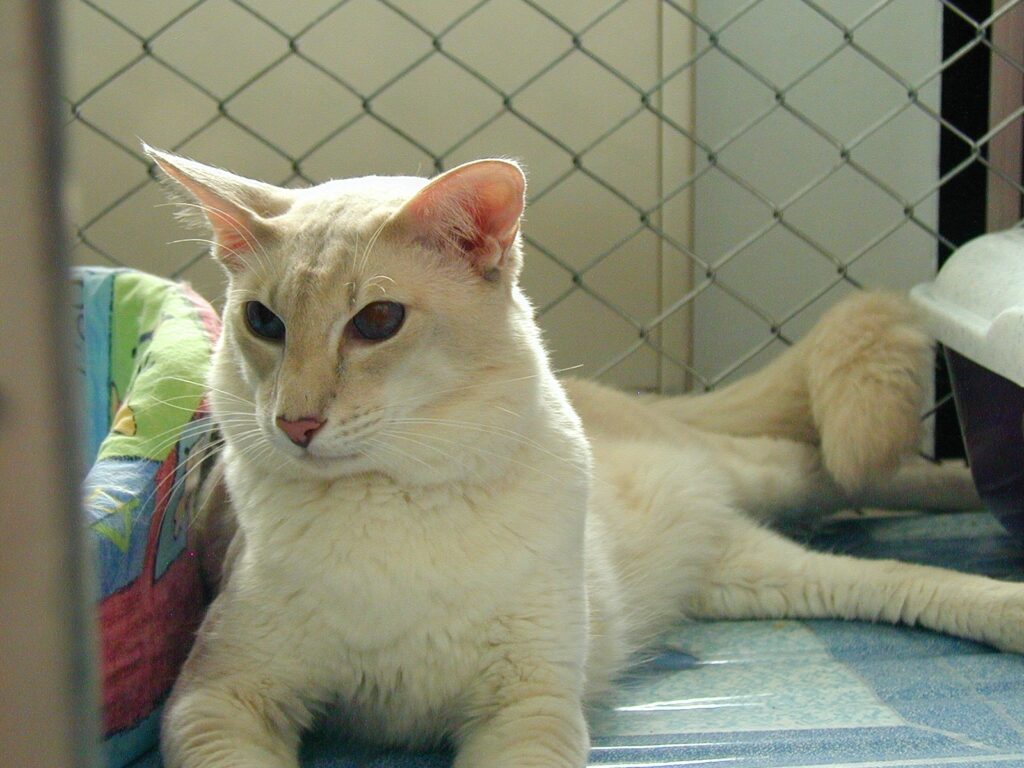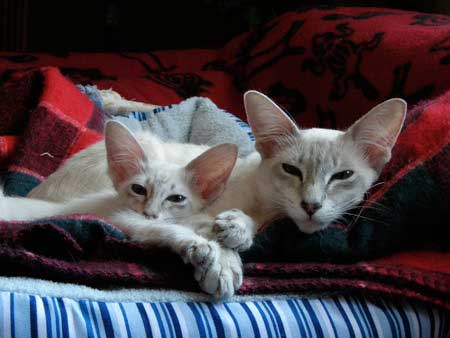Content |
|---|
Characteristics "Javanese cat (Colorpoint Longhair)"
Coexistence is important that you have with your new friend. Before considering the acquisition of a cat of the breed "Javanese cat (Colorpoint Longhair)" you know certain factors. You must take into account their character, their need for exercise, their interaction with other pets, their care and if you have small children, their level of tolerance towards them.
Joy5.0 out of 5 stars (based on 1 review)
|
Activity level5.0 out of 5 stars (based on 1 review)
|
Friendliness to other pets3.0 out of 5 stars (based on 1 review)
|
|---|---|---|
Friendliness to children3.0 out of 5 stars (based on 1 review)
|
Grooming requirements2.0 out of 5 stars (based on 1 review)
|
Vocality5.0 out of 5 stars (based on 1 review)
|
Need for attention5.0 out of 5 stars (based on 1 review)
|
Affection towards its owners5.0 out of 5 stars (based on 1 review)
|
Docility2.0 out of 5 stars (based on 1 review)
|
Intelligence5.0 out of 5 stars (based on 1 review)
|
Independence1.0 out of 5 stars (based on 1 review)
|
Hardiness3.0 out of 5 stars (based on 1 review)
|
History
The origins of the Javanese cat
Also known as Colorpoint Longhair, the Javanese is a fairly rare breed of cat.
Contrary to what the various exotic names might suggest, was created in the United States.
In 1978, American breeders of the Balinese cat and the Oriental shorthair cat crossed the two races to develop a new one with a personality similar to that of the Siamese cat, but with longer hair and a greater variety of colors.
So, the Javanese cat descends from Oriental shorthair cat, but also of the Siamese cat, since the Balinese cat is a Siamese longhair.
Of these two ancestors, is clearly the Balinese cat the one that most resembles its general appearance: has inherited the fact that its tail ends in feather-like hairs. This explains the name Javanese, as the Indonesian island of Java is close to Bali: It, Therefore, a nod to its resemblance to the Balinese cat -although, by the way, the balinese does not come from Bali like the Javanese cat makes it Java…
The cats Javanese and balinese they differ in the colors of their robes. In the case of the first, all dress colors are accepted. For the balinese, However, only colors are allowed point blue, chocolate, lilac and seal.
The recognition of the breed
The Javanese cat (Colorpoint Longhair) has caused a lot of controversy and debate about whether this cat is really a new breed., or simply a variety of Balinese cat. Major government bodies around the world remain divided, but many consider it a variety of Oriental Longhair cat, not a separate breed.
In 1979, the International Cat Association (TICA) recognized the Javanese cat as a race in its own right, with the name of Oriental Longhair cat. But, later he changed his mind and grouped him with the Siamese cat, the Balinese cat and the Oriental shorthair cat, considering all four as one race, the group of Siamese breeds.
The Cat Fanciers’ Association (CFA) did exactly the same thing: after recognizing the Javanese cat as a distinct breed in 1986, renamed it as Oriental Longhair cat in 2002 and classified it as an Oriental variety, in the same way as the Oriental shorthair cat. In other words, unlike TICA, the CFA regards Orientals as a race in their own right, especially for its wide variety of colors.
The Fédération Internationale Féline (FIFé) accepted the Javanese cat as a race in its own right in 1985, but with the name of Oriental Longhair cat. It is classified in the group of oriental breeds, along with the Siamese cat, the Oriental shorthair cat, the Balinese cat and the Seychellois cat.
The British Ruling Council of Feline Fantasy (GCCF) he took the same position when he recognized it in 1997: he also kept the name of Oriental long-haired and integrated it into the group of oriental breeds, where the Siamese already appeared, the Balinese and the Oriental Shorthair.
For its part, the Livre Officiel des Origines Félines (LOOF), French reference body, decided to associate the Javanese cat with the Balinese cat. Like this, considered at the Javanese as a balinese with green eyes and a wide range of coat colors.
It also, whatever the official body, accepted crosses are :
- The Javanese cat with another Javanese cat;
- Javanese cat and Siamese cat;
- Javanese cat and Oriental shorthair cat;
- Javanese cat and Balinese cat.
Physical characteristics
"Javanese cat (Colorpoint Longhair)" |
||
|---|---|---|
The Javanese cat has inherited the physical characteristics of the Siamese cat, from which it descends: the only important difference is that it has a long coat and can be of a greater number of colors.
It is, because, of a long-haired or oriental cat that is distinguished by its great elegance. In fact, its silhouette is very well balanced and its movements are graceful.
Medium-sized, tubular and very muscular, their body it is flexible, thin and has a fine bone structure. The tail it is also thin and tapers towards the tip, where the hair is feathered.
The Hips and shoulders they are equally wide and are attached to legs slender and well muscled. The latter are high, but the ones in the back are even taller than the ones in the front. Both legs end in small feet oval.
The head rests on a long neck, thin and muscular. It is medium in size and triangular in shape, long and narrow. The skull and the forehead are flat. The profile is straight from the forehead to the nose, which is long and thin. The cheeks they are flat, but the double chin is accepted in the male. The eyes almond-shaped, they are far apart and are usually emerald green. But, individuals with a multicolored coat may have pearly eyes, while those with white fur may have blue eyes. The ears are especially large, long and wide at the base.
The Javanese cat does not have undercoat, but a top layer of medium long hair, fine and silky, which is shorter on the shoulders. All coat colors and patterns are accepted, except the Colourpoints.
Last, the Javanese cat presents a lightweight sexual dimorphism, since the male is slightly more solid than the female. It also, the male may have jowls, which does not happen with the female.
Size and weight
- Size: 30 to 35 cm.
- Weight: 3 to 5 kg
Character and skills
"Javanese cat (Colorpoint Longhair)" |
||
|---|---|---|
 | ||
If he Javanese cat shares many traits with the Siamese in terms of appearance, it also has a temperament quite similar to that of the Siamese, even if you are less demanding in daily life.
But, by being at the same time intelligent, loving and playful, but also stubborn and possessive, it should be noted that he has a strong personality.
Very faithful and attached to its owners and the people with whom it lives, loves pampering, but also spending time with them and participating in family activities. It's even easier to integrate it into the family, as you can learn to walk on a leash and, Therefore, to be taken for a walk.
Gets along very well with children and enjoys playing with them, as long as you are treated with respect and attention. In any case, for the sake of both, a cat should never be left alone with a young child without adult supervision. This applies regardless of race.
It is common for the Javanese to be especially attached to a specific member of the house, who is usually the person who takes care of you the most. Combined with your curiosity, this closeness can make them a bit sticky dogs to the point of following them everywhere, sleep with them and monitor all their movements from morning to night.
By being very observant and intelligent, does not hesitate to take advantage to learn and reproduce them. That is why it is not strange to see him, for example, opening a door, a drawer or even emptying a bag.
But, it is possible to use these skills to teach your cat tricks. These may include, can teach your cat to search for and retrieve objects, just like a cat. In fact, the Javanese is an easy to train cat breed.
To keep your cat happy, it is necessary to stimulate it mentally. Enjoy games that require thought and cunning, such as kibble labyrinths or any other toy that involves difficulty. Giving him a part of his daily ration through a dispenser or toys that appeal to his intelligence is also an excellent thing., because it also helps you to satiate more quickly: this helps prevent this little wolverine from becoming obese, to which you are predisposed.
It's also a good way to keep you busy when you're away., since his attachment to his humans makes him not bear to be alone. But, as you suffer from separation anxiety, soon begins to behave destructively. So, it is preferable not to leave you alone for a long time or too often, and leave him toys to take care of when he's out. In any case, a person who spends most of his days away from home and cannot take it with him would be better off with a more independent representative of another race.
Another solution may be to share your home with another dog.; this playmate is sure to help you pass the time, and vice versa. But, things tend to go much better when he comes in second place, or when both enter the house at the same time. If you are used to being the only cat in the house and a newcomer enters, is likely to be jealous and possessive, but also to defend its territory against this invader.
Due to his closeness to family, the javanese is also a breed of cat that meows a lot. In this case, has a remarkable ability to vary his vocalizations according to the object of his request, to gradually educate their masters to recognize them. He does not hesitate to communicate with his humans and ask for all the attention he needs., generally achieving without difficulty to make oneself understood.
For seniors, this can be a bit exhausting in the long run, given the attention and response it requires. If they also have difficulty moving and he always hinders them, certain situations can even become dangerous. Again, another cat breed choice is potentially more appropriate.
In any case, the Javanese cat behaves very differently with people he doesn't know: he is as reserved with them as he is close to those he meets on a daily basis.
On the other hand, a dog with whom you share your home can be perfectly regarded as your friend, especially if you have lived with him since he was very young. Otherwise, a gradual adaptation is necessary for coexistence to work.
Although he is sociable with his family, your companions and even dogs, the Javanese cat he is still a formidable hunter. Even if you have been with him since he was very young, a rodent or a bird would never be completely safe with it, because his predatory instinct could take over at any moment.
This instinct, combined with your curiosity, makes, if you have access to a garden, do not hesitate to abandon it to follow its prey. So, there is a great risk that you will end up getting lost by getting too far away from your territory. Thus, A GPS collar for cats can be a wise investment so you know where your cat is at all times and don't worry unnecessarily.
In any case, fear of losing it is no reason to keep it locked up when living in a house with a garden. In effect, this little feline, very athletic, agile and lively, needs space to run, frolicking and climbing. It is clear that they are happier in a house with a garden, but they can get used to living in a flat, as long as it is big enough, are stimulated and have a cat tree. You should also remember to provide a scratching post if you don't have access to the outside., as furniture and curtains can be very comfortable for scratching.
Last, just because it's generally very active and moves often doesn't mean it can't also be calm and restrained at times.. Like this, their closeness to their humans is not incompatible with the fact that, like any cat, you also need your moments of solitude; everyone must respect them, since it is an indispensable condition for its development.
Health
The Javanese cat is generally in good health, although it is prone to certain diseases:
- Asma, which is similar to chronic bronchitis. With proper treatment, the life of the animal is not in danger and can lead an almost normal life;
Genetic strabismus, that slightly reduces visual acuity and is not treatable; - The glaucoma, which is caused by a sudden increase in pressure inside the eye. If not treated quickly, may cause blindness;
- The progressive retinal atrophy (ARP), an inherited disease that also ends up causing blindness. The difference is that it is incurable;
- The hyperesthesia syndrome, a rare disease that is manifested by occasional or regular attacks, during which numerous symptoms may appear (spasms of the skin of the back, dilated pupils, frantic licking of certain areas, aggressiveness…). Treatment is possible, but it depends on the cause of the problem, which is often difficult to identify;
- The amyloidosis, a rare and incurable inherited disease for which there is currently no genetic screening test. It usually occurs before the 5 years and causes kidney failure;
- The periodontal disease, an inflammation of the structures that support the teeth caused by the accumulation of tartar.

It also, the Javanese has a predisposition to Obesity. Easily gluttonous, you can quickly gain a lot of weight and get into a vicious circle, since an overweight animal has less desire to move and, Therefore, tends to get even fatter. Obesity can cause or aggravate many health problems. Obviously, the risk increases if the dog spends its life confined between four walls, no access to the outside world…
As with any race, adopt a Javanese cat of a serious breeder gives you the best chance of adopting a healthy animal. In addition to a veterinary certificate that certifies that the animal is really healthy, the breeder must be able to show the details of the vaccines administered to the animal (registered in your health card, or vaccination book), as well as the results of any genetic tests carried out on the parents or offspring to counteract the risk of hereditary diseases.
Once adopted, regular veterinary care is, as in the case of any feline, the best way to keep your pet in good health. In particular, a full check-up should be performed at least once a year to diagnose any potential problems as soon as possible and, at the same time, make sure you are up to date on your vaccinations.
At the same time, the owner must renew his antiparasitic treatments whenever necessary, so that your partner is always protected.
Grooming
Like any cat, the Javanese cat requires a little maintenance every week.
First of all, it is necessary to brush your coat to remove dead hairs and avoid knots. As it has no underspeed, this is quite easy.
At the same time, wiping the corners of the eyes with a damp cloth can reduce the risk of eye diseases.
You should also take the opportunity to clean your dog's ears with a damp cloth to prevent infections..
The weekly maintenance session is also an opportunity to brush your cat's teeth with a toothpaste specially designed for cats.. This prevents tartar buildup, that doesn't just cause bad breath, but it can cause various diseases, some of them very serious (like septicemia, for example). Do not hesitate to do it even more often if your dog accepts this treatment easily., especially since this breed is prone to periodontal disease.
Last, it is essential to check the length of the cat's nails at least once a month. If the cat lives outside, natural wear and tear is usually sufficient. But, if you live in a flat, this does not usually happen, and it is even recommended to do it more often. In any case, how long are they too long, it is necessary to cut them by hand, with the risk of them getting in the way or even breaking, with the risk of injuring them in the process. It also, if you do not have access to the outside, you have to provide a scraper to do your needs, at the risk of you using the furniture instead.
The first time, It may be convenient to learn from a veterinarian or a professional hairdresser the correct gestures and reflexes to take care of the coat, the eyes, the ears, your cat's teeth and nails. It also, no waiting to get started: the sooner you get used to it, sessions are more likely to go well, especially since his proximity to his master makes things easier.
Food

It is even more necessary to pay attention to your diet since you tend to be overweight or even obese. In addition to providing you with adequate daily rations, it is essential to control your weight through regular weighing, At least once a month. If your dog is overweight and persists during several heavy (or even gets worse), it is essential to take it to the veterinarian. The veterinarian will be able to determine if the problem is due to a disease, a medicine that is not well tolerated or a diet that is not adequate in terms of quality and/or quantity. Once the diagnosis has been made, may propose a solution to the problem.
Last, it is absolutely essential that the Javanese cat have continuous access to available water. This is true of any cat, but even more for him, that is prone to hyperesthesia, that causes kidney failure.
For sale "Javanese cat (Colorpoint Longhair)"
The price of a Javanese cat often haunt them 1000 EUR.
But, in Europe, the limited number of breeders Javanese cat makes it sometimes necessary to have patience.
Another solution is to go abroad to get the cat. In the United Kingdom, the cost is usually about 500 pounds (a few 550 EUR). In United States, country of origin of the breed and with the largest number of breeders, the average cost is 1.500 $.
In the case of an adoption abroad, it is necessary, of course, find out about legislation on the importation of animals, to comply with it. It also, administrative and transport costs shall be added to the purchase price of the kitten.
whatever the country, the price that is requested may differ from one copy to another depending on its lineage, the reputation of the hatchery from which it comes, and, above all, of its own characteristics, especially the physical ones.
Alternative names:
Videos "Javanese cat (Colorpoint Longhair)"
|
|
|
|---|


